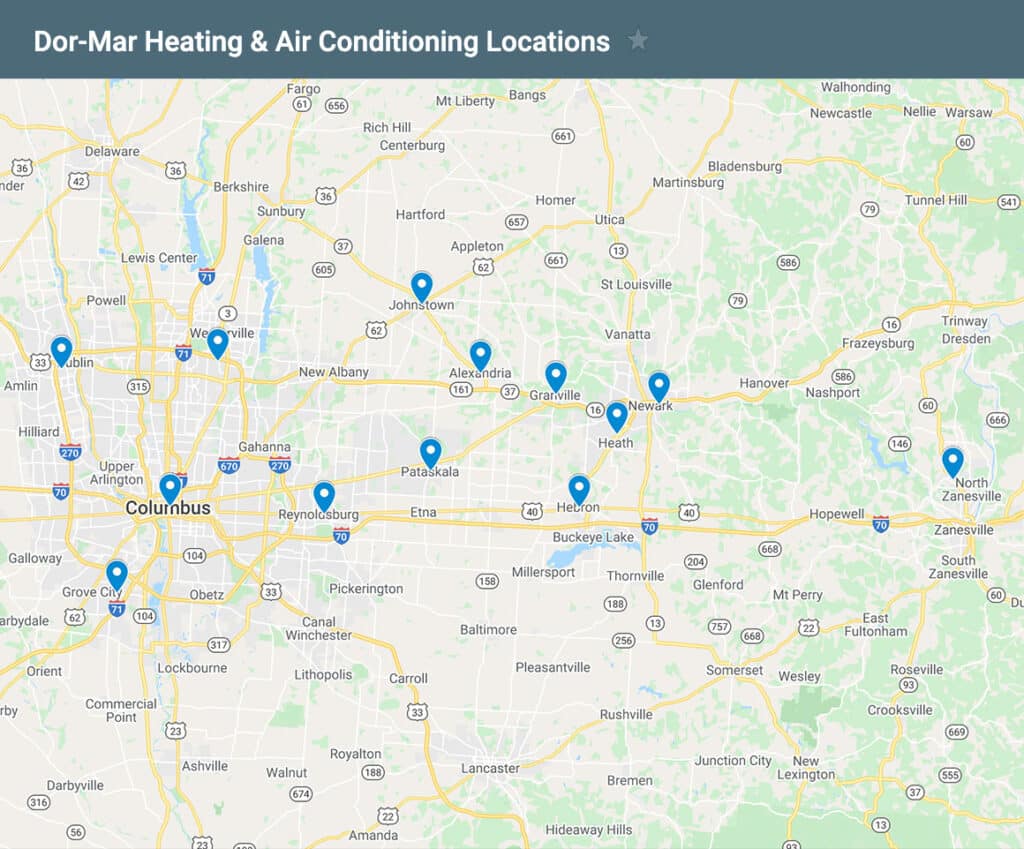HVAC Glossary
Search on this page for commonly used HVAC terminology to help you better understand your Dor-Mar service technician or replacement estimate.
Click an item in the list to jump to that item below.
ACCA | ACH (Air Changes Per Hour) | Air Conditioner | Air flow | Air handler or air handling unit | Annual Fuel Utilization Efficiency (AFUE) | ASHRAE | Balance Point | Boot | British Thermal Unit (BTU) | Capacitor | Checking the charge | Coil | Compressor | Condenser | Controller | Delta T (ΔT) | EPA Certification | Evaporator | Furnace | Grille | Heat Exchanger | Heat pump | Heat Source | High Efficiency | Humidistat | HVAC | Latent heat | Line set | Load Calculation | Load calculation | Media air cleaner | MERV | NATE | Plenum | Refrigerant | Refrigeration cycle | Register | Return | SEER | Split system | Standard Efficiency | Static Pressure | Supplementary Heat | Supply | Thermostat | Tons of air conditioning | Trunk | Two-stage | Variable Speed | Zoning System |
| TERM | DESCRIPTION |
|---|---|
| ACCA |
A major trade association for the HVAC industry, the Air Conditioning Contractors of America. |
| ACH (Air Changes Per Hour) |
The number of times per hour a room’s air is replaced through ventilation. |
| Air Conditioner |
An appliance designed to dehumidify and extract heat from a home or office, leaving the remaining air cooler. |
| Air flow |
The volume of air your duct system moves. In general, air conditioners are designed to move about 400 cubic feet per minute (cfm) for each ton of air conditioner capacity. |
| Air handler or air handling unit |
A large metal box, part of the indoor unit for a furnace/AC system that contains the blower and heating or cooling elements. |
| Annual Fuel Utilization Efficiency (AFUE) |
The thermal efficiency measure of space-heating furnaces and boilers, expressed as a percentage. |
| ASHRAE |
The American Society of Heating, Refrigerating, and Air-Conditioning Engineers. |
| Balance Point |
The outdoor temperature at which a heat pump’s output matches heating needs. |
| Boot |
The section of shaped sheet metal that transitions the duct on one end to the grille or register on the other end. |
| British Thermal Unit (BTU) |
One BTU is the energy required to raise one pound of water one degree Fahrenheit. |
| Capacitor |
Also known as a ‘run capacitor’, it gives an air conditioning system the initial boost it needs to turn on and also provides continuous power. |
| Checking the charge |
Measuring the pressure of the refrigerant of an AC system to determine if it contains the proper amount. |
| Coil |
Part of the air conditioner that performs heat transfer to air, mounted inside an air handler or ductwork. |
| Compressor |
A device that raises the temperature and pressure of the refrigerant in an air conditioning system. |
| Condenser |
A heat exchanger that removes heat from the HVAC system. The condenser is the ‘hot’ side of an air conditioner or heat pump. |
| Controller |
The part of an HVAC system that controls all or part of the system, usually based on input from a thermostat. |
| Delta T (ΔT) |
Measurement of the change (delta) of the temperature of air moving through the evaporator coil. |
| EPA Certification |
A certification required by the Environmental Protection Agency (EPA) for HVAC technicians to be able to handlle refrigerants. |
| Evaporator |
Part of the basic refrigeration cycle that absorbs or adds heat to the system, usually to absorb heat from the air. |
| Furnace |
Part of an HVAC system that adds heat to the air of a home. |
| Grille |
Register used primarily in return air vents that doesn’t contain any moving parts. |
| Heat Exchanger |
Part of an HVAC system that transfers heat from the hot parts of the system to the cold parts. |
| Heat pump |
Moves heat from inside to outside in the summer months and from outside to inside in winter. |
| Heat Source |
A source from which heat is collected, such as outdoor air for heat pumps. |
| High Efficiency |
Based on the AFUE rating of a furnace, usually referring to a 90% or higher efficiency furnace. |
| Humidistat |
A device that controls indoor humidity levels by adjusting moisture in the air. |
| HVAC |
Abbreviation for Heating, Ventilation, and Air Conditioning. |
| Latent heat |
Heat that must be removed from the air to remove moisture. |
| Line set |
Tubing that connects the condensing unit to the evaporator coil of an air conditioner. |
| Load Calculation |
Determining the correct HVAC system size for a home based on heat gain/loss. |
| Load calculation |
The process of determining the proper size of an air conditioner and/or furnace for a home. |
| Media air cleaner |
More efficient air filters for an HVAC system, constructed of materials that catch smaller particles. |
| MERV |
A rating for filters used in HVAC systems. The higher the MERV rating, the more particles it catches. |
| NATE |
North American Technician Excellence, a certification for HVAC professionals. |
| Plenum |
The sheet metal box connected to either side of an HVAC system’s air handler. |
| Refrigerant |
The coolant that enables modern air conditioning systems to remove heat from the home. |
| Refrigeration cycle |
The cycle that allows an air conditioner to transfer heat from inside and send it outside. |
| Register |
Cover for a heating or air conditioner grate inside a home, usually with movable louvers. |
| Return |
The section of an HVAC ductwork system that returns air from the house back to the air handler. |
| SEER |
Seasonal Energy Efficiency Ratio, measuring air conditioning and heat pump cooling efficiency. |
| Split system |
An air conditioning system with an indoor unit and an outdoor condensing unit. |
| Standard Efficiency |
Refers to an AFUE rating of a furnace, typically in the 80% range. |
| Static Pressure |
The pressure inside a home’s ductwork system, affecting HVAC efficiency. |
| Supplementary Heat |
Auxiliary or emergency heat used when temperatures drop below a heat pump’s balance point. |
| Supply |
The part of a home’s duct system that moves conditioned air into the living space. |
| Thermostat |
A device that monitors and regulates an HVAC system. |
| Tons of air conditioning |
The capacity of an air conditioning system. One ton equals 12,000 BTU/hour. |
| Trunk |
A large piece of ductwork that attaches directly to the plenum and distributes air. |
| Two-stage |
An air conditioning system with high and low settings for efficiency. |
| Variable Speed |
HVAC motors that adjust speeds for improved energy efficiency and comfort. |
| Zoning System |
Divides a home into sections that can be controlled independently for comfort. |



